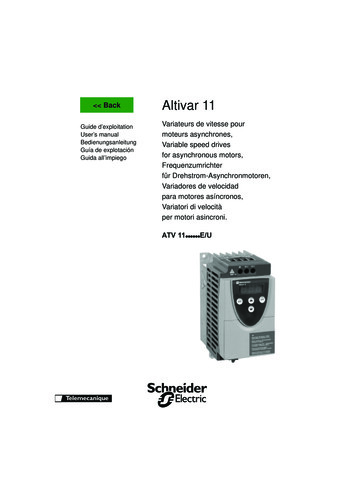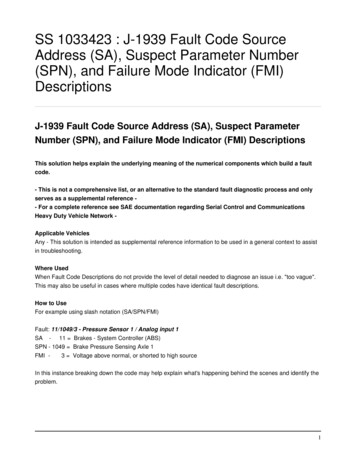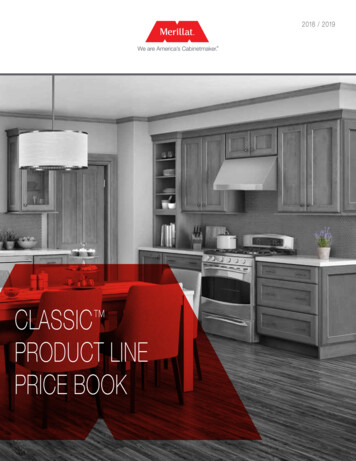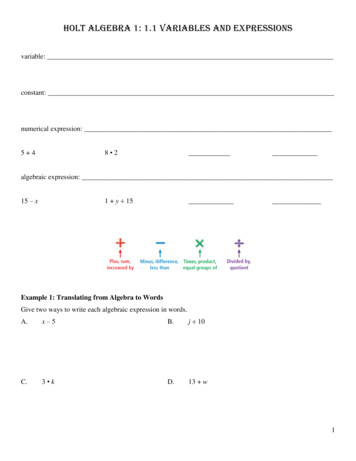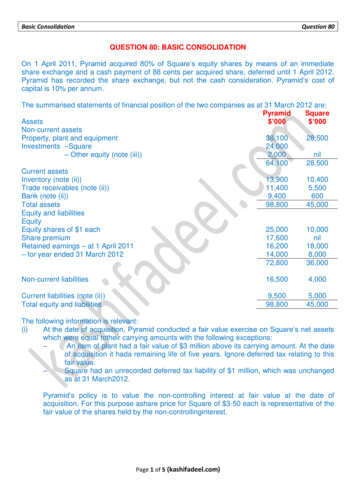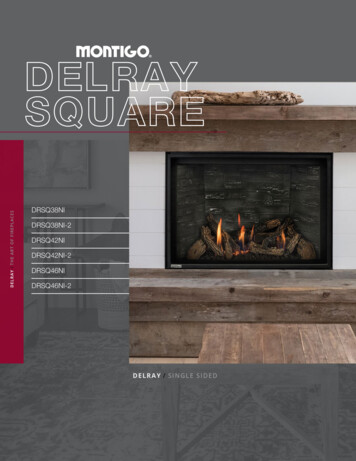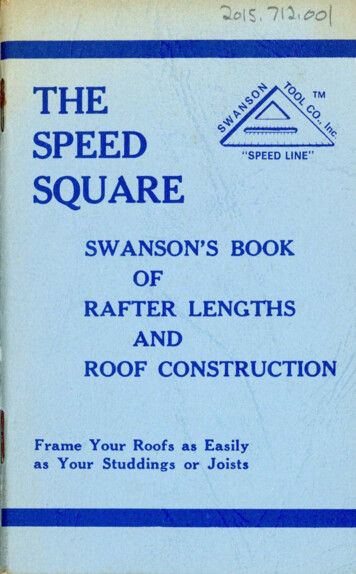
Transcription
tTHESPEEDSQUARE"SPEED LINE "SWANSON'S BOOKOFRAFTER LENGTHSANDROOF CONSTRUCTIONFrame Your Roofs as Easilyas Your Studdings or Joists
You've got our Square .Now, Get our Saw Set!HEAVYD UTYSAWSETStop f ighting dull saw blades.Reset the teeth with aSWANSON SAW SETFast and Easy -Right on the Job(see inside back cover for more detai l)Write to Swanson Tool Co. for currentprices, or . see your local dealer.ENLARGED SECTIONOF DEGREE SCALE1015 I Io.,oTHE SCALE .DEGREES. A CROSS BOTI0h4 (LONGLEG) OF SQUARE ALLOWS US ER TO ""4ARK ANDt,,,1EASURE HIS WORK IN DEGREE S. THE LONG LINESWITH A HEAVY BLOCK LINE BETWEEN MAKES IT h4UCHEAS IER FOR THE EYE TO PI CK OUT A LOCATION ONTHE SCALE.SWANSON TOOL COMPANY, INC.P. 0 . Box 434, Oak Lawn, Illinois 60453Ph one : (312) 599-9 029Nol : E d1 hu . y blod Ii" i1 1 wide. Eed1 1peu i1 2 wide .
THE "ONE NUMBER" METHODFOR ANY PITCHED ROOFThe one number method developed by theSwanson Tool Co. simplifies roof framing towhere roofs are really framed as "easily asyour studdings or joists."Following is a brief description of the various rafters, how to get the different cuts,where to measure from, what is meant by"run" and "rise," information about the hipand valley rafter, etc.This book has been r ewritten with the use ofmore pictures in the hope it will be of greaterbenefit to those who are not as familiar withroof construction as the tradesman. Good planning will save time and material.NOW WITH FULL 90 DEGREE SCALEThe square has been redesigned with theaddition of a full 90 degree scale, which willenable the user to m ark any angle in degrees,as well as all the angles represented in "inchrise per foot run." You can easily· convert degrees to inch rise or vice versa at a glance.The square makes an excellent guide for theelectric saw to run against and is very handyfor trim work.2COMMON RAFTER : One running at rightangles (90 ) from plate to ridge. The commonrafter will form t h e diagonal leg ( hypothenuse ) of a 90 triangle, with the rise and runforming the 90 angle of the triangle ( Fig. 1) .Fig. 1 also shows correct points from whichto measure. Study them and remember thepicture when you are on the j ob. Wh ere thearrows show I Rafter Length I. these a rethe lines to measure from. When your lumberis not straight, always put the crown or highside up when laying out any rafter. When laying out rafter as shown in Fi g. 1 ( lets ass ume5" rise ), start at top end of rafter. Lay s:i:uareon face of rafter, with "T" bar of s:i:uaredown over the edge of rafter. Pivot S1Uare towhere number 5 on common scale lines upwith same edge of rafter as pivot p oint. Keeppivot point tight against edge of rafter. Startyour mark at pivot point, marking along topedge of square. See drawing in front of book.This gives the top plumb cut, to fit againstridge.M easure the rafter length along top edge ofrafter. Mark another plumb cut same as above.This line represents outside wall of the building. (The same point from which you measu·red the width of the building ). Add whatever length you want for a tail or eave to therafter lengths given in the table in back ofbook. Mark at end of tail on rafter is plumb3
cut, same as one at top end of rafter ( Fig. 1 ).The tails of the rafters may be cut on theground, or wait until rafters a re all in placeand mark t he ends to a line and cut- wh at everis the easiest. To get the Bottom or Heel cutsee Fig. 2.VALLEY RAFTER: One running diagonally from t he plate to the ridge at the intersection of gable extension with main roof( Fig. 7) .HIP RAFTER : One running diagonallyfrom th e plate to t he ridge ( Fig. 7).Since both hip and valley rafters run at a45 angle to the common rafter, they bothrepresent the diagonal or hypothenuse of aright tri angle; the three sides being the h ip,plate and common rafter, or the valley, ridgeand common rafter. Therefore, the cuts andlengths ap ply equally to hip and valley r afters(Fig. 3) .common rafter rises 12" in only 12" of h orizontal run. This r equires a different angle forthe plumb cuts. In Fig. 4, square is held onr after and pivoted in the same ma nn er as wit ha common rafter, but using th e Hip-Val scale.If building is out of square, one hip will becut a little shorter, depending on h ow greatthe error is. Keep longer corner at top end ofhip u·p even with top of ridge. Keep ridge andhips well propped up until roof boards arenailed. Watch that you don' t put a bow inridge or hip while nailing other rafters tothem.You will notice the square has a sep a r ateHi p-Val Scale which must be used for eitherof these two rafters. But always use the s a ' )'Wnumb er on Hip-Val scale as you used on t hecommon rafter scale- the number represen ti nginch rise. The reason for the separat e Hip-Valscale is that the hip and valley rafters run at45 to the common rafter, and th erefore mu stbe longer. In Fi g. 3, the hip rafter h as ahorizontal run of 17" to rise 12", while theTo find intersection points of center of hipson ridge, leave ridge about a foot too long atpoint where both hips intersect the rid ge.Take a regular length common rafter (suchas used on main roof). Set bottom cut overedge of plate and in line with rid ge . Make sureyour walls a re straight. Place top end of common rafter along side of the ridge, bringingtop point of common even with top of ridge( Fig. 5). Mark across top of ridge at thispoint. This mark is the center line of the twointersecting hips. The common rafter used toget this intersection point would be placed inthe same position as the one in Fig. 7 thatcomes in lin e with th e ridge and runs underneath the little dormer on the 20'0" wall side.This way you know the rise of the hips willbe the same as the rise of the common rafter45
on main roof. Leave the bottom ends of thehi ps (eave end ) a li t tle short so t hey will :notinterfere with lining up t he facia boa rds atthe corner.JA CK RAFTERS: One whi ch does not extend from plate to ridge. Hip Jack - one running from plate to hip at 90 to plate. V all eyJack - one running from ridge to vall ey at90 to ridge. Cripple Jack - one whi ch n eithertouches the ridge nor plate, but runs from a hiprafter to a valley rafte r at 90 to the rid ge(Fig. 7) .The rise and run of a jack rafte r are thesame as that of a common rafter . Wh en m arking jacks use the common rafter scale andsame number (inch rise). Wh ere rafter r estsagainst hip or valley, ma rk plumb cut. thencut at 45 angle along this ma rk. Th is willgive both plumb cut and side cut ( Fig. 4 ).When resting on ridge or plate, lay out thesame as for the common rafters. For cri pplejacks, mark plumb cu ts on both ends and sawat 45 as above.When measuring the length o'f the jackrafter, measure from longest corner (plumbcut on 45 ) to other plumb cut mark. alongTop Side (same as shown in Fi g . 4 for hiprafter ) . Cripples are meas ured from long poi ntto long point diagonally along top edge. Measuring to the long point (Fig. 4) will compen6sate for 1/z of the ridge thickn ess ( or forjacks, % of valley or hip thickness). Ther e isno problem in layi ng out these an g les on t herafters as long as you keep in mind which sideof the hip ( or whatever ) you want t he rafterto fit against. Usually a carpenter will spacethe cei ling joist from an outside wall andworking to a 48" cent er. This gives properspacing for dry wall or panelling 01' wh '.lteveris used. Proper sp ac ing of ce iling joist wi ll ai din roof constructi on. Measure shortest j ackfirst ( usu ally running next to a ce iling joist ) ,from plate to hip rafter. The difference inlen gth of the rest of the jacks is taken fromchart. Set each rafter along side cei lin g joistand spike well. The ceiling joist then ti es theroof together.Figure the rafter material lengths so you·can cut a lon g a nd short jack rafter from eachpiece. When you have cut your shortest jack,the angle of the long end will then fit on theother side of the hip. Do this all the way upthe hip, always leaving the cut off end for t heother side. If lumber has crown in it, putcrown up on longest cut off piece.In some cases a carpenter will build thevalley on top of the main roof, n ot using avalley rafter. This of course would be th eeasiest way on any remodelin g job , room addition, etc. It saves cutting into and we;1kening the ma in roof. Mark locati on of valley on7
roof boards, 45 to common rafters (S eeDormer , Fig. 7) . Set long point of bottomend of rafter even with this line ("G" of Fig.7 ). The top cut of t he rafter is the same astop cut of common. Bottom end is a horizontalcut, same as Bottom or Heel cut tr.at fits ontop of plate, and is marked in same way, butextends all the way across rafter ( Fig. 2 ) .Th en ti lt the base of your saw to the sameangle as the roof on which the bottom end ofthe rafter will r est. I.E. , if rafter end is to fiton a roof with 6" rise, you would ti lt the baseof saw to an angle of 26% 0 (6" rise) and cutalong horizontal line. With saw set at thisangle you wi ll see t hat it fits over the pointedend of top of common rafter, because thiswould also be a 26 % 0 (6" rise) angle. Saveth e cut off ends for the other side.Fig. 7 shows a roof as is sometimes usedover a door. See "H." To get the pointed endcut, the Square is held in position for theplumb cut of the fiat roof. Then a line runningfrom the pivot corner of the Square thru thenumber representing the rise of the MainRoof is the cut wanted.PLYWOOD ROOF SHEATHINGWhen using plywood for a roof sheathingit is best to do the angle cutting on the horsesas follows: from the far left hand co rner ofa 4 x 8 foot sheet, measure to the right the8distan ce given for the pitch wanted ( measurements given in following cha rt ) . From thispoint draw a line back to the nea r left handcorner. These measu·rements are for a perfectly square roof. Better check the firs t piececut for any changes required.For roofs of 6" pitch or steeper, the bevelcan be cut with an electric saw that tilts to45 . For a flatter pitched roof it is best toleave the saw set at 90 and use a valley stripmade as follows : Scribe a line %" from theright hand edge of a 2" piece. With the sawti lted, rip at this line. The strip should be thethickness of the roof boards at the thick edge.M e asure fr o mc orner o f P lyw oodInch R isep e r f oot run3'3'3'3'3'3'3'3'3'3'3'3'3'2'2'2"2 'h"3"3 1h"4"4 'h"5"5 'h "6"7"8"9"10"11"12"911 % "11"10%"lO Vs "9%"9"8 %"7 %"6 'Vs "5 %"3 'Vs "2 %"'Vs"11 %"9 'Vs"
FOR UNEVEN PITCHED ROOFSIf your roof has no hips or valleys and youhave more than one pitch, cut each sectionseparately using the number representing t hepitch of that section.For instance, if the front section is 8" riseand 12' run, yo u would use number 8 and findyo ur rafter lengths under 24' width. Thenwe'll say th e rear is 3" rise and 16' run. Usenumber 3 on the Square, and 32' bui ldingwidth for your length . The top cut to fitagainst the ridge is plumb for both sections.Your rear plate would be 4' high er.DETERMINING THE RISE OF A ROOFA "Full" pitch roof is one havin g a 24"rise for 12" run. Following is a Table of various pitches. Pitch equals rise divided by span;being the proportion the rise bears to the span.Inch RunInch 08642Pitch11 / 125/63/42/37/ 121/ 2 - mean ing roof5/ 12rises a distan eequal to 1/2 of1/31/4building width .1/61/ 12Assume your bui lding has an 18' wide spanand you want an 8' rise . Expressed as anequation:.Rise x 12I nch nseper foot run - - - RunThe rise here is 8' and the run is 9' ( 1/z of8 x 1296span) so: - - - or 10 % " rise. Round99thi off !o !he closest inch ( in this case 11" ) ,which will increase the rise by 1h " x 9' or 3"for this bui lding. Now you· can look in raftertable under 18' building width and 11" riseand your rafter is 12' 21/z " . This does n ot include any overhang. If exact length is neededsee Fig. 1. (Also Page 12, Note.)Fig. 7 gives one example of the use of thesetables. The main building is 20' wide x 30'long with a 7" rise. Thus, the hip rafters are15' 3 % " long, and the common rafters 11' 7".The 15' x 15' addition, hips and valleys are11' 5 % " long and the commons 8' 8% ". Forthe 10' Gable Dormer on top of the roofboards, the longest rafters are 5' 91/z".1011USING THE RAFTER LENGTH TABLESIn the following pages are tables giving th elengths of any common, hip or valley rafterfor any' pitch up to a 24" rise, and for building widths up to 40 feet. (See Page 12. )
A "width in inches" table is found in backof book which gives the amount to add forinches in case th e width does not measure outin even feet. Simply add the length given forthe inches in relation to the rise, to t he lengthgiven for the even foot tab les. Lengths givendo not include eave projection.right triangle, it can be used to measure anyangle with the use of the degree scale.A study of the following diagrams will showthe principals used. These principals can beapplied in different ways to meet variousproblems.It is best to use a steel tape in m easu ringthe width of building, measuring from outsideto outside of plate upon which rafters willrest, or if boarding extends to top of platemeasure to outside of boards. If a ridge boardis used, deduct the thickness. of same f rombuilding width.To mark degrees on a flat surface see Figs.8 and 9.For building widths greater than is givenin this book, take any two widths whi ch whenadded together equal the width w:rntcd. Findthe lengths for these two widths and add themtogether; for instance for 49' width takewidth of 20 and 29 and add together.Fig. 11A - With plumb line AB set on 45 mark, the square. is now positioned so thatthe bottom (long side) 0 square is runninglevel, 90 to plumb line.NOTE: Lengths of rafters for pitches 2112 ,3%, 41/2, 5 % : Use lower pitch then add 1/2 ofdifference to next higher pitch .To find degrees in an upright or verticalposition, Fig. 10 shows two methods by· whicha plumb line can be used on the square. Fig.11 gives illustrations of the use of a plumbline on the square.Fig. 11B - By swinging the square upagainst line XY, the plumb line has shifted15 . Thus the unknown angle in llA was 15 ,with angle ABX 60 . This same 15 reading also indicates bottom edge of square issetting at a 15 incline.The same pivoting method used to determine rafter cuts is used with the degree scale.By remembering that the square forms a 45 In looking at Fig. llA and B, it is possiblethat sometimes the plumb line will not fallfrom pivot point to a point on the degree scaledue to the position of line XY. In this case,rather than setting the edge of the square to1213THE DEGREE SCALE
line XY, simply turn the square over and letline XY run behind the square. Line XY willthen run from pivot point to some point on thedegree scale; such as shown in Fig. llC. Nowset plumb line AB on square. The number ofdegrees on scale between plumb line and angleline indicates measured angle.Length of Rafter per Foot Run(In Inches)Rise123RAFTER LENGTHS PER FOOT RUNSeldom does the roof on a house havegreater than a 112 pitch, which is a 12"1·ise per foot run. For a steeper roof, a tableis provided which gives any rise from 1" to24". The figures given are the length per footrun of any given rise. (See table on page 15.)I.E ., assume the roof has a 22" rise per footrun . With a 22" rise, the length per foot run ofa common rafter is 25.06 inches. Assume building is 50' wide. The run of the common would25 x 25.06626.50be 25' ( 1/z of width).inches. Divide by 12 and you have 52.208 feetor 52' - 21/z " ( .21 x 12 gives you- the 2Yz").Deduct % thickness of ridge from this length. Hip or Valley rafter would be figured thesame p-ValRaftersRafters12.04 224.1925.0625.9426.8317.03 327.0027.7828.5829.3915
dFIG. IIIITHE COMMON RAFT ER.·v1 ,' ,l"-.i. 0 .r\I"-''"RUNBOTTOM OR HEEL CUT"JRUNO TOP ORPLUMB CUT 1, 2 OF SPANINCH RISE PERSETS ON TOP OF PLATE(Fig. 21RISEFOOT RUNTO FIGURE RAFTER LENGTHRAFTERLENGTH---vRUN lTRISE2NOTE : WHEN USING RIDGE BOARD, DEDUCT I 2 RIDGETHICKNESS FROM RAFTER LENGTH , IF USINGTHIS EQUATION.-- PLUMB MARK .;r . . ."'"'.,§-:tIFIG. 2LA YING OUT BOTTOM ORHEEL CUT1RUN12
FIG. 3"&,i.RELATIONSHI P BETWEEN RUN OF HIP OR VALLEY RAFTERTO THE RUN OF THE COMMON RAFTERO,(';-\,A IN 02" ,. ((.-fl.,- .00b12"a,RUN Of COMMON RAFTERPLAN VIEW17"RUN - - -· FIG. 4.SID E CUT IS 45 ANGLE TO FIT AGAINST RIDGE\LA YING OUT HIP OR VALLEY RAFTERLENGTHI.I OIIIII'\BOTTOM CUT: MARK PLUM B CUT, THEN BOTTOM CUT A TRIGHT ANGLE TO PLUMB CUT. USE HIP-VAL SCALE.(F;g. 21PLUMB CUT MARKED FROM HIP-YAL SCALE. USE SAME NUMBERAS USED ON COMMON-NUMBER REPRESENTING INCH RISEPER FOOT RUN - TI LT SAW TO 45 ANO CUT ALONG PLUMBMARK . THIS WI LL G IVE BOTH PLUM B AND SIDE CUT WITHONE SAWING OPERATION.
MARK SHOW ING THE CENTER LINEOF THE TWO INTERSECTING H IPSRIDGEt'O0FIG. 5FINDING IN TERSECTING POINTSOF HIPS ON RIDGECUT RIDGE ABOUT 2" LONGE R THAN MARK,SO YOU CAN NAIL THRU RIDG E INTO H IP PROVIDING NO CENTER COMMON RAFTER ISUSED. IF ONE IS USED RIDGE MUST BE CUT ATTH IS MARK.--.- ,,,. Ii JJjO ;;0nmZr OOv, 5;:o) i (j)(j)V - .t'O.\/I o E!!o I - 1/-no nOn ,.coIO 1';11,r - ) I.,.,) (j) uo- o s ,-- O ; z !IO z o: IQ ozm: "TI ;--! ) ) .,.,) -n IC -;-1;::;;::: 0,.
FIG. 7N)N) · · · 11 coM. RAI""· I -""Jc' t .I I I I C\( R.t·J·iER7 \NCH p\iCH-ts EACH / LONGERROOF\ - b :z./6',o ;, Is·o·· - , ,, ,., 0· o··I,.ALL CUTS ON THIS ROOF MADE BY USINGTHE NUMBER 7 (INCH RISE)FIG. ·9SQUARE SHOWN IN l DIFFERENT POSITIONS WITH THERESULTING ANGLES BEING FOUND BY PIVOTINGSQUARE AT POINT 8 ONUNE X-YyN)c,:,
FIG. 9SQUARE USED IN TWO POSITIONS GIVING FULL 180 xif'( ' - --- - y"N .,.7iy!lo/.So600LINE X-Y REPRESENTS EDGE OF MATERIAL, POINT B IS PIVOT POINT OF SQUARE. HERE SQUARE IS NOT PIVOTED .POINTS ARE MARKED ON MATERIAL AT POINT B, AND AT DESIRED ANGLE. LINE DRAWN THRU THE TWO POINTSGIVES THE ANGLE WANTED.N 01PLACE A 7" (OR LONGER ) LEVEL ON FACE OF SQUAREWITH TOP EDGE OF LEVEL ALWAYS RESTING AGAINST" T" BAR AT PIVOT POINT ON SQUARE. BUBBLE SHOULDALWAYS INDICATE THAT THE LH'EL IS BEING HELD PLUMB.PIVOT SQUARE FROM EDGE OF LEVEL USING THE LEVELAS A PLUMB LINE WILL GIVE FASTER READINGS BECAUSEYOU DON'T HAVE TO WAIT FOR THE SWI NG ING MOTIONOF THE STRING (AS USED IN THE NEXT METHOD ) TO STOP.ARROWS INOICA TE POINT AT WHICH DEGREE IS SHOWN.-------SQUARE HAS A NOTCH AT PIVOT POINT THROUGH WHICHA SMALL STRING CAN BE PLACED. ATIACH A STRAIGHTPIECE OF WIRE TO THE STR ING WHICH Will ACT AS AWEIGHTED POINTER, ALWAYS HANGING STRAl(iHT DOWN(PLUMB) . YOU MAY WISH TO EXTEND THE STRING PASTTHE DEGREE SCALE ANO PLACE SOME TYPE OF SMALLWEIGHT ON THE END TO MAKE IT HANG PLUMB.
iN cr,4S '"'"N .:,USING 3 8" PLYWOOD FOR THE SOFFITWHEN A WIDER EAVE IS WANTED. IF YOUGO VERY W IDE ( 24 ") SOME TYPE OFSUPPORT WILL BE NEEDED TO SUPPORTCENTER OF Pl YWOOO . NAILING UP THRUPLYWOOD INTO SUPPORT.USING A 2 1 10 FOR TOP PLATE.THIS WORKS BEST ON A FLATER PITCH ROOF (ONE WITH 4INCH RISE OR LESS).W HERE VERY LITTLEOVERHANG IS USED.
wmmInchRi s e3 FEETHipCom.12.34567891011121·- 6nr"1'- 6l4."1'- 6%.",,1'- 71'- 7 .z"1'- 81,s"1'- 87/s"1'- 9%"1'-101h"1'-11%"2'- %"2'- l'Ai"InchRise1234567891011122'- Ph "2'- 1%"2'- 1 7/s"2'- 2 "2'- 2%",,2'- 32'- 31h"2'- 4%"2'- 47/s"2'- 5%"2'- 6%"2'- 7%"o FEETHipCom.2'- 61,s"2'- 61h"2'- 72'- 7%"2'- 81h"2'- 91h"2'-10%"3'- 1Ai,,3'- 11h"3'- 31k"3'- 4%"3'- 6 ".wmmOF Bun.DING3'- 6%"3'- 6%"3'- 7 "3'- 7%"3'- 814",,3'- 93'- 9%"3'-107/s",,4'- 04'- 114."4'- 21h",,4'- 428In ch4 FEETHipCo m.2'- 1k .2'- %"2'2'- 1%",,2'- 22'- 2%"2'- 3% H2'- 47/s",,2'- 62'- 714"2'- 8%",,2'-10*"2'-10 H2'-1014"2'-10 .z"2'-107/s"2'-11%",,3'- 03'- %"3'- 1 "3'- 2%"3'- 3%"3'- -i%"3'- 6 1f ."6 FEETHipCom.3'- 1Ai"3'- ,,3'- 1%",,3'- 2,,3'- 33'- 414"3'- 6%"3'- 71,4"3'- 9 "3'-107/s"4'- 7/s,,4'- 27/s"ni se123456789101112Inch.4'- 34'- 314"4' - 3%"4'- 4%"4'- 51/s "4'- 64'- 71/s"4'- 81,4"4'- 9% "4'-11% "5' - %"5'- 2%".OF Bun.DING7 }'EETCom.3'- 6 1111"3'- 6%"3'- 714"3'- 8%"3'- 9 1h "3'-11 "4'- %"4'- 2 .z"4'- 41h"4'- 6%",,4'- 94'-11%"8 FEETCom.HipHip4'-11 .z"4'-117/s"5' - 14 H5'- PA.",,5'- 25'- 3 "5'- 4 14"5'- 5%"5'- 7 1,4",,5'- 95'-10%"6'- %"Rise9 FEt:'J.'HipCom.1234567891011124'- 614"4'- 6%"4'- 7%"4'- 9 H4'-10 .z"5'- %"5'- 2%"5'- 4%"5'- 7 .z"5'-10%"6'- 114"6'- 4%"4'4'4'4'4'4'4'4'5'5'5'5'-1Ai,,%"1 .z"2%",,45%"7%"9%",,021h"51,s"7%",,5'- 85'- 8%"5'- 87/s"5'- 9%"5'-10%",,6'- 06'- 11h"6'- 3 "6'- 47/s"6'- 6%"6'- 8%"6'-11%"10 FEETHipCom .6'- 41h",,6'- 56'- 51h"6'- 6%"6'- 7%",,6'- 96'-10%"7'- %"7'- 21h"7'- 4%",,7'- 77'- 91h"295'5'5'5'. 5'5'5'6'6'6'6'7'-14"%"17/s"314",,57 1111"91h"%",,361,s"9%"7/s,,.7'- 17'- 11h"7'- 21A,"7'- 314"7'- 41h",,7'- 67'- 7%"7'- 9%",,8'- 08'- 21h"8'- 51,s"8'- 7%"
wmrnOF Bun.DINGRise11 FEETHipCom.1234667891011125'- 614"6'- 75'- 85'- 9%"5'-111h" ·6'-1%"6'- 41h"6'- 7%"6'-101h"7'- 27'- 61h"7'- 9%#Inch18 FEETHipCom.InchRise123466789101112.6'- 61,4"6'- 71Ai"6'- 81,,"6'-1014"7'- ,ii"7'- 31,4"7'- 6%"7'- 9%"8'- ,ii"8'- 6%"8'- 9%,"9'- 2%"WIDTH OF BUil.DINGIn ch12 FEETHipCom.7'- 91h"7'-10 "7'-10%"8'- 08'- 1%"8'- 38'- 4%"8'- 71,i,"8'- 9%"9' - % ''9'- 314"9'- 614".6'· 14"6'- 16'- 214"6'- 3%"6'- 66' - 81,,"6'-11%"7'- 21h"7'- 67'- 9%"8'- 1%"8'- 6%".8'- 6 "8'- 61h"8'- 7%"8'- 8%"8'-101.4"9'- 09'- 21,i,"9'- 4%"9'- 71,4"9'-101,4"10'- 1%"10'- 4%".H FEETHipCom.9'- 21,,"9'- 3 "9'- 4 "9'- 6%"9'- 7%"9'- 99'-111.4"10'- 210'- 4)ia"10'- 81,ii"10'-11%"11'- 3 ".307'- 1,4"7'- 11,i,"7'- 2%"7'- 4,ii"7'- 7 "7'-108'- 1%"8'- 68'- 99'- 1%"9'- 6 "9'-10%".Ri se.9'-119'-11%"10'- %"10'- 2%"10'- 3%"10'- 610'- 81,,"10'-11%"11'- 21,,"11'- 6 "11'- 9%"12'- 1,ii".123456789101112InchRise12345678910111215 FEETHipCom .7'- 6 14"7'- 7 14"7'- 8%"7'-10%"8'- 1 .,"8'- 4%"8'- 8%"9' - 14"9'- 4 .,"9'- 914"10'- 2%"10'- 7%"16 FEETCom.Hip10'- 71h"10'- 8%"10'- 914"10'-10%"11 '- *"11 '- 3 "11'- 5%"11'- 8*"12'- 1,1i "12'- H "12'- 7*"12'- 11 %"17 FEETHipCom.8'- 6')s"8'- 7 .i"8' - 91Ai"8'-11%"9'- 21h"9'- 614"9'-10 14"10'- 2%"10'- 71h"11'- %"11'- 61h"12'- l"-,,8' - %"8'- 1%"8'- 3 "8'- 514"8'- 8 "8'-111h"9'- 314"9'- 7%"10'- 010'- 510' -10 14"11 '- 3*".11'- 411'-11'- 5%"11'- 71h "11'- 9%"lll' - 012'- 2%"12'- 61AJ"12'- 9%"13'- 1%"13'- 5%"13' -1014".18 FEETCom.H ip12'- 1h"12 '- 114"12'- 21h"12'- 414"12'- 6 .,"12' - 913'- 013'- 31h"13'- 714"13' -ll 1h"14' - 414'- 8 %".319'9' "38%"2 .i "8*".H ".12'- 912'- 9%"12' -11 IAI "13' - 113'- 3%"13'- 6 "13'- 914"14'- %"14'- 4%"14··- 9%"15'- 215' - 7.
WIDnl OF Bun.DINGWIDnl OF Bun.DINGInchInchRiseii FEETHipCom.19 FEETHipCom.13'- 61h"13'- 6%"13'- 7%"13'- 9%"H'- 14 .,,H'- 3H'- 6%"H'-101.4"16'- 21,{i"16'- 71.4"16'- %"16'- 6%"16'-11 "17'- 6 "17'-11%"18'- 61,{i"19'- 1.4,,,,19'- 710'- %"10'- 1%"10'- 3%,"10'- 61h",,10'-1011'- 21,4"11'- 7 "12'- 1.4",.12'- 61.4,,13'13'- 6%"H'- 1%,",.H'- 916'- 4%"16'- %",,16'- 817'- 4%"18'- 14"H'- 2 "H'- 2%"14' - 4-%"H'- 6%",,H'- 9,.16'- 016' - 3%"16'- 7%"16'- %"16'- 6 "16'-10%"17'- 3%"17'- 9%",,18'- 418'-101,{i"19'- 61,4"20'- 14,,20'- 7%""18'- 8%,"21'- 2%"18'- 6%"l!IO'- 91,4"19'-61,4"21'-10%"21'- H1"22'- 622'- 0,.20'- 1%"2219'- 1%"19'-10%"20'-10%"23'- 1%"2320'- 6%"22'- 7%"21'- 7%"23'- 9%"2421'- 2%"28'- 31,4"22'- 4%"U'- 612346678910111213H161617189'- 6%"9'- 7%"9'- 9%"10'- 14"10'- 3%"10'- 7%"11'- %"·'11'- 6 "11'-101,{i"12'- 41,{i"12'-10%"13'- 61,4"H'- 1.4,,H'- 71.4"16'- 21,{i",.16'-1016'- 6%"17'- 1%"1917'- 91,{i"20'- 22021.32,,,,21 FEET22FEETRiseCom.HipCom.Hip12310'- 6%"10'- 7"",,10'-1011'- %"11'- 41il",,11'- 9,.12'- 212'- 7%"13'- 11,{i",,13'- 8,,H'- 3H'-101il"1''-11%"16'- 116'- 3%"16'- 6%",.16'- 916'- %",.16'- 616'- 9%"17'- 2%"17'- 8%"11'- %"11'- 1%"11'- 4%"11'- 7%",.11'-1112'- 3%"12'- 8%"13'- 2 ",,13'- 9H'- 3%"H'-11%H16'- 7,,15'- 816'- 91il"16'-11%"16'- 2%,.,,16'- 6 667891011InchRise123456789101112.28 }'EETHipCom.11'- 6%"11'- 7%"ll'-10%"12'- 1%"12'- 5%"12'-10%"13'- 3%"13'- 9%"14'- 41h"14'-11 %"15'- 7%"16'- 3%"16'- 31h"16'- 41h"16'- 6%"16'- 8%"16'-11%"17'- 3 "17'- 7%"17'-11%"18'- 5 "18'-10%"19'- 4%"19'-11 "33,,16'-10 ,.17'- 2%"17'- 7%"18'- %"18'- 61,{i"24 FEETHipCom.12'- %"12'- 1 %"12'- 41h"12'- 7%"13'- 0 "13'- 6 "13'-10%"14'- 6 "15'- 0 "15'- 7%"16'- 3%"16'-11%"17'17'17'17'17'18'18'18'19'19'20'20'-0 "1%"2 "614"8%"0 "4%"9%"21h"8%"2%"9%"
wmraInchRise112'- 6%""212'- 83412'-10%"13'- 2%"56713' - 61h"13'-11%"89InchRiseOF Bun.DING25 FEETHipCom.14'- 5%"15'- 14"15'- 71h"WIDTH OF Bun.DINGInch26 FEETHipCom.17'- 8%"17'- 9%"17'-11%""18'- 218'- 514"18'- 9 II19'- 11h"19'- 672 1120'- %"27 FEETHipCom.13'-Rise1h"13'- 21ifi"18'- 5 "18'- 61;4"13'- 4%"18'- 813'- 8%"14'- 1 II18'-10% 1119'- 2%"14'- 6%"15'- %"15'- 7 .i"16'- 3 "19'- 6"II19'-10% 1120'- 3% 1120'- 9%"FEETj!J8,,1213' - 6%"13'- 81;4"19'- 11h"19'- 2% H14'-313'-11"19'- 4%"14'- 514 1120' - 11,4"414'- 2%"14'- 9%"20'- 4%"667814'- 7%"19'- 71h") 9'-11 H16'- · 7%"16'- 2% H20'.- 7%"91016'-101h"17'- 7 II21'- 7% 1122'- 2 II111218'- 3%"22'- 9II19'- 11Ai."2 ·- 4 .i1116'- 1H.,20'- 321'- ll.41134%"14'- 21416'- 211,,19'-1019'-1114 II20'- 7%"16'- 7%"21'- 0II16'- 2%21'- 6II1116'- 9%,,17'- 61118'- 2%18'-11 %"1119'- 9% 1121'-10%"22'- 6 II22'-11 %"23'- 72,ii"24'- 34567891011In chHipCom.23Rise12345678ll10111229 FEETHipCom.14'- 6% 1114'- 8% 1114'-11%"15'- 31h"16'- 8%"16'- 2% 1116'- 9%"17'- 61ifi"18'- 11h"18'-10%"19'- 8 II20'20'20'21'21'21'22'22'23'23'24'-30 FEETCom.Hlo61h"7%"9%11%"4%, H9 "2%"8 "2%"9%"61;4"31 F EE1.'Co m.Hip15'- 6 %"15'- 81h"15'-11%"16'- 4%."16'- 91h 1117'- 4 "1117'-11 .!18'- 7%"19 - 4 ,i"20'- 214"21'- %1121'-11 "21'-ll'h"22'- %"1122'- 31ifi22'- 6%"22'-10%"23'- 3 "23'- 81h"24'- 2*"24'- 9 25·- 5%"26'- 1 .i"26'-101,ii""3515' 16'15'15'16'16'17'18'18'19'20'-%"2%"51h"9%"3 "9141141h".*II96%"'41;4 H21'- 3 II21'- 4 11 %21'- 61h"21'- 9%"22'- 11h"22'- 6 "22'-11% II23'- 6%"24'- 1ifi"24'- 71h"25'- 3%"32 1'' EETCom .Hip16'- %"16' - 2%"16'- 5%"16'-10%"17'- 4 II17'-10%"18'- 6%"19'- 2%"20'- 0 "20'-10 II21 ·- 81h 11i2'- 7 ,i"22'- 8 "1122'- 91h22'-11%"23'- 3 "23'- 7%,"24'- 0 "24'- 5%"25'- 'Ai"25'- 7%"26'- 314"26'-11%"27'- 8%"
WIDTH OF BUll.DINGWIDTH OF BUll.DINGInchRise1234567891011121314Inch33 FEETCom.16'- 6%"16'- 8%"17' - 0 "17'- 4%"17'-101h"18'- 5%"19'- 1%"19'-10 "20'- 71h"21'- 5%"22'- 4%"23' - 4 "24'- 41/s"25'- 414"34 l'EETHipCom.Hip23'- 4%"23'- 6 "23'- 814"23'-11%"24'- 41/s"24'- 9 "25'- 2%"25'- 91h"26'- 627'- :' Vs"27'- 9 .28'- 6%"29'- 4%"30'- 3 "17'- %"17'- 2%"17'- 6 14"17'-11 "18'- 5 "19'- %."19' - 8%"20'- 51/s"21'- 3 "22'- 11h"23'- iii"24'- %"25'- %"26'- 11h"24'- 1 "24'- 21h"24'- 4%"24'- 81h"25'- iii"25'- 6 "26'- %"26'- 6iii"27'- 2%"27'-10%"28'- 7%"29'- 514"30'- 314"31' - 2 "35. FEET36 l'EETInchRise12345678910111213HInchSS FEET37 FEETCom.HipCom.Hip18'- 6%"18'- 9 "19'- %"19'- 6%"26'- 21,i"26'- 4%"26'- 6%"26'-10%"27'- 31h"27'- 9 "28'- 3%"28'-11 "29'- 7%"30'- 41h"31'- 21,i,"32'- %"32'-1114"33'-11 "19'- % "19'- 3 "19'- 7 "20'- %"20'- 7 "21'- 3 "22'- lh"22'-10 "23'- 9 "24'- 8%"25'- 9%"26'-10%"28'- %"29'- 2%"2 '-11 "27'- %"27'- 3%"27'- 7%"28'- %"28'- 6 "29'- %"29'- 81h"30'- 5 . "31'- 2%"32'- lh"32'-10%"33'-10 "34'-10 "1 "1%"2"31,i,"5%"40 FEET39 FEETRiseCom.HipCom.HipRiseCom .Hip1217'- 6%"17'- 8%"18'- %"18'- 5%"18'-ll)h"19'- 6%"20'- 3:Ys"21'- %"21'-1072''22'- 9%"23'- 8%"24'- 9 "25'- 9%"26'-10%"24'- 91h"24'-11 "25'- ll).i"25'- 51,4"· 25'- 9%"26'- 3 "26'-10 1,.C27'- 41,4"28' - 14 .28'- 8%"29'- 5%"30'- 3%"31'- 1 %"32'- 1 "18'- %"18'- 2-Vs"18'- 6%"18'-11 %"19' - 6 "20'- 11h"20'-10 14"21'- 71h"22'- 6 "23'- 51/s"24'- 5 "25'- 51h"26'- 6%"27'- 77,,s"25'- 6 "25'- 7%"25'-101/s"26'- 1 %"26'- 6%"27'- 0 "27'- 6%"28'- 1%"28'- 9%"29'- 6%"30'- 4 "31'- 2 "32'- %"33'- 0 "1219'- 6%"19'- 9%"20'- 1%''20'- 6%"21'- 11h"21'- 9%"22'- 71,i,"23'- 514"24'- 41h"25'- 4%"26'- 51h"27'- 7 "28'- 91i"29'-11 Iii,"27'- 71,i"27'- 914"28'- 0 "28'- 41,ii"28'- 9 14"29'- 3 "29'-10 "30'- 5%"31'- 2%"32'- 14"32'-1014"33'- 914"34'- 8%"35'- 9 20'20'21'21'22'23'24'25'26'27'28'29'30'-%"3%"7%"1 "8"4%"2 "%"0"%"1%"3%"6"87Ai"28'- 4 "28'- 5%"28'- 8%"29'- %"29'- 6 "30'- 0 "30'- 714"31'- 314"32'- 14"32'-101,i,"33'- 8%"34'- 7%"35'- 7%"36'- 8 "
AMOUNT TO ADD FOR l TO 11 INQIAMOUNT TO ADD FOR l TO 11 INCHBun.DING WIDffl COM. RAF.Rise %%%%%%.%.%.%%.%%% 11111,a1%1141141%21341% 21% 1%1% 1%1% 1%1% 1%11.4 1%.11,4 1%1% 21% 21% 2%11h 21,41% 2%1% 2%1% 2lni1% 2%1%., 2%.1 % 2%232323%2% 31,421,4 3%2% 3%2!ni 3%2% %4%.51,s6%56789wmm10112% 3% 3% 4% 4% 5% , %71488148%99%9%10%10%10%.111.411 11%11%12%13%1414%.OF BUILDING HIP RAF.InchRise 11234567891011121314151617181920212223242623456% 1% 21,{i% 1% 21,a% 1% 214% 1% 214%. 11h 214%. 1% 214% 11h 214% 11h 2%%. 1% 2%% 1% 2%7/s 1% 21h7/s 1% 2%7/s 1%. 2%7/s 17/s 2%1227/s123123123121/s 314l1h 214 3 1411,s 214 3%114 2% 31h114 2% 3%114 2% 3%114 2% 37/s2%2%2%333331,s3143%3%31h3%3%37/s4444 555145 7/s661,{i6%61h6%77147%7%3978ll10114% 5o/s 6% 77%55% 6% 71,{i 7%55% 6% 714 7%5% 5% 61h 714 851,{i 5% 6% 7% 81,{i514 66% 71h 8145% 61,{i 6% 7% 8%51h 514 77% 8%5% 6% 714 887/s5% 6% 7% 814 957/s 67/s 71h 8% 914667/s 7% 8% 9 1h6% 714 77/s 87/s 9%6% 7% 8 14 914 10 1/s6% 7% 81h 9% 10%6% 7% 8% 9% 10 %789 10 117
This book has been rewritten with the use of . side up when laying out any rafter. When lay . 3 . cut, same as one at top end of rafter (Fig. 1). The tails of the rafters may be cut on the ground, or wait until rafters are all in place and mark



